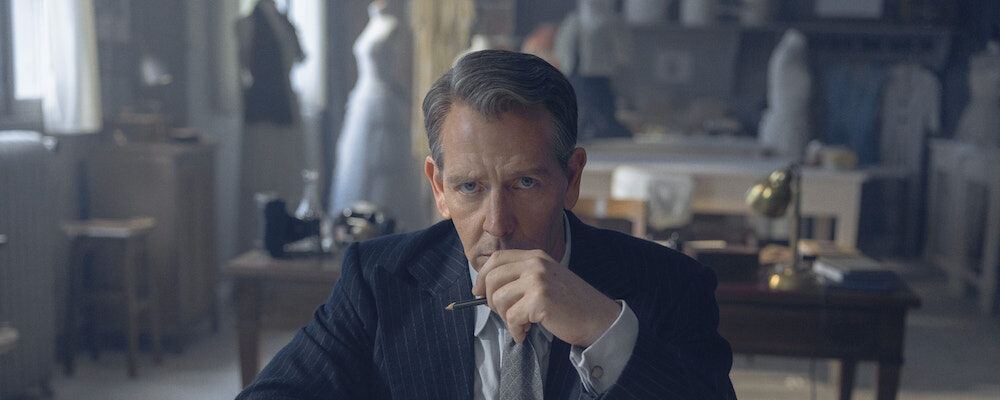‘The New Look’ Stylishly Pits Christian Dior Against Coco Chanel as Fashion Faces Fascism in WWII Paris
Alci Rengifo
It’s easy to forget how famous brands have been swept into major historical events. Apple’s “The New Look” explores how a few essential fashion designers dealt with life under the Nazi occupation of France. Coco Chanel, Christian Dior, Cristóbal Balenciaga and Pierre Balmain make for quite the well-dressed lineup. Fittingly, “The New Look” is a visually great series shot with appropriate richness. It is also unique in how it studies the way elites tend to collaborate with invaders in order to protect their own interests. Much of this is so fascinating you are tempted to forgive its overlong structure.
“Damages” creator Todd A. Kessler should also be commended for choosing a fresh angle to World War II. Dior (Ben Mendelsohn) is introduced first as a respected designer in 1955 France. He’s going to speak at the Sorbonne. The celebratory mood is broken when Dior is asked about the stories concerning him designing for the Nazis during the war, while Coco Chanel (Juliette Binoche) eventually preferred exile. The narrative then goes to 1940s Paris. A younger Dior works under the wing of Lucien Lelong (John Malkovich), which includes designing ball gowns for the wives of Nazi officials. Chanel, by then already an established fashion name, faces financial ruin. Her brothers have fled to the U.S. and she has no access to the company accounts. Both designers are confronted with hard choices. Dior’s sister, Catherine Dior (Maisie Williams), has joined the underground resistance and is hunted by the Nazis. Chanel meets Hans Von Dincklage (Claes Bang), a German intelligence officer and soon begins a dangerous relationship.
“The New Look” is another one of those streaming series that could have been a great, tight film. But it moves along with energy, even if at times it threatens to become too much of a thriller, throwing the fashion titans onscreen into constant close calls. Ironically, what is much more thrilling are the inner battles the characters face. This is the rare WWII series that deals with how higher circles willingly fell into fascist hands. Any situation involving invasions and occupations produces collaborators. “The New Look” challenges us to try and understand the decisions made by Christian Dior, Coco Chanel and others. Catherine Dior will eventually face torture and the very real prospect of death, which forces her brother to not surrender his position, but try to use it in order to rescue her. Is it the wrong choice? Chanel’s relationship with Von Dincklage also raises tricky questions. None of the designers sympathize with the Nazis and Chanel jokingly tells Heinrich Himmler that she has never been one to worry about laws. Deep down she would like to contact her old friend, Winston Churchill, and help the war effort, so is Chanel’s choice understandable in the desperation to survive? Dior gets badgered by fellow designers, like Balenciaga (Nuno Lopes), for knowing he does indeed have a choice, but would rather dance with the devil.
Such dilemmas are contrasted with the opulent world of “The New Look,” which is gorgeous with its lush interiors and rich wardrobes. Florence + the Machine, the 1975, Lana Del Rey and Perfume Genius are featured on the soundtrack, which evokes the bygone Paris of the war years. Juliette Binoche is stylish and so she effortlessly inhabits the character of Chanel. Malkovich is himself a fashion designer and glides through the surroundings with total ease. The same goes for Glenn Close as Carmel Snow. A weaker series would be all about the style. These actors and the environment take on an eerie glow because we also see the Nazis torture resistance fighters, chat about race laws in fashionable restaurants and issue threats. All the glamor can’t mask the terror that is actually going on. While “The New Look” is never uninteresting, at ten episodes it can get redundant.
When it works, “The New Look” can have the same subtext as the recent film “The Zone of Interest” in how they look at strikingly relevant questions. In any time period, people of status will be forced to choose how to defend their position in the world. Dior may be understandably trying to protect his sister, but it weighs on his conscience that he continues to design for the Nazis when Dior employees can no longer take it and quit. He can say it is also out of loyalty to Lelong, but there are countless excuses one can make to turn away from evil. Binoche’s Coco Chanel is stripped of romanticism and at times can even come across as jaded, no doubt from convincing herself there is no other way to defend having wealth than to collaborate. No one here comes out unscathed and even designers who choose to flee know deep down they were tempted to give in, if just for a moment. This is a story that would have been great as a film, but it is still essential that it is being explored in any format.
“The New Look” begins streaming Feb. 14 with new episodes premiering Wednesdays on Apple TV+.

